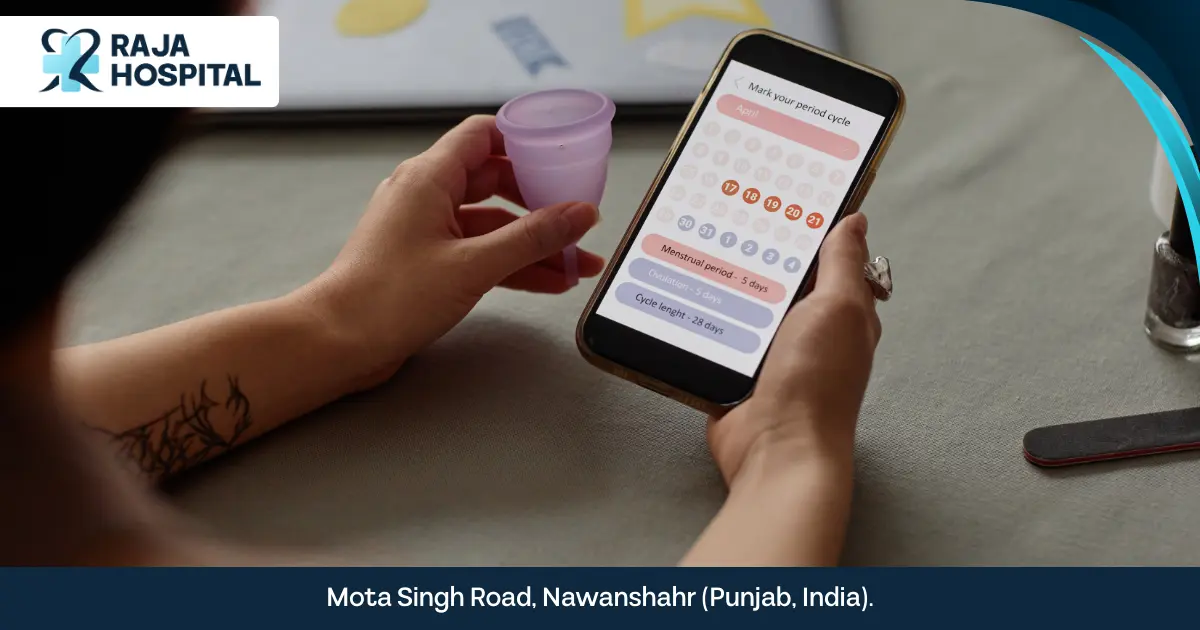Is Your Period Healthy? Learn How to Track It Easily!

REVIEWED BY DR. Lakshita Saini (mbbs, ms obs & Gynae) on 23 july 2025.
Let me ask you something. Do you really know what your period is trying to tell you?
If your answer is “not really,” you’re not alone. Most women are just told to expect it once a month and deal with the cramps, mood swings, and cravings. But what if your cycle could actually help you understand your health better?
Maybe your period is all over the place. Perhaps it comes early, skips a month, or feels way too painful. You wonder if it’s normal, but then you dismiss it.
Here’s the truth: your period is more than just a few days of bleeding. It’s like your body’s monthly update. And if you learn how to track it properly, you can spot patterns, catch problems early, and feel more in control of your health.
In this post, I’ll walk you through how to track your cycle, what’s considered normal, when to see a doctor, and why it all matters. Let’s make tracking your period feel simple, not scary.
Understanding the Basics of a Menstrual Cycle

Before we get into tracking, let’s clear up what a menstrual cycle is. It’s not just “your period.” It’s the full cycle your body goes through, starting from the first day of one period to the first day of the next.
What is a “Normal” Cycle and Why Everyone’s “Normal” is Different?
A typical cycle is around 28 days, but anything between 21 to 35 days is considered normal. What’s important is consistency. If your cycle is 26 days one month and 34 the next, that could be a sign that something’s off.
Also, your cycle may shift slightly due to stress, travel, illness, or even changes in your diet. So don’t panic if it’s not always exactly the same each month.
Common Phases: Menstrual, Follicular, Ovulation & Luteal

Here’s a quick breakdown of the four main phases:
- Menstrual Phase (Days 1 to 5): This is when bleeding happens. Your body sheds the uterine lining.
- Follicular Phase (Days 1 to 13): Starts on the same day as your period. Your body prepares an egg for release.
- Ovulation (Around Day 14): The egg is released. This is your most fertile time.
- Luteal Phase (Days 15 to 28): Your body either prepares for pregnancy or starts the next cycle.
Understanding these phases can help you make sense of mood swings, energy shifts, and other body signals.
Why You Should Track Your Cycle Religiously

Tracking your cycle isn’t just for people who are planning a pregnancy. It’s actually one of the smartest ways to stay in tune with your health, notice early signs of problems, and feel more in control of your body.
Health Signals Hidden in Your Period Patterns
Your period can reveal a lot about your overall health. If your cycle is always changing, your bleeding is too heavy, or cramps are getting worse each month, it could point to something deeper, like hormonal imbalance or thyroid issues.
When you track your cycle, you’re building a pattern. You’ll start to notice things like how many days your period lasts, when you feel bloated, or when your energy dips. These patterns give you clues about what’s normal for you and help your doctor if something feels off later.
How It Affects Mood, Weight, Productivity, and Fertility

You’re not imagining it; hormones really do affect your mood, energy, sleep, cravings, and even how focused you feel. These changes occur as your estrogen and progesterone levels fluctuate throughout the month.
When you track your cycle, you can use this info to your advantage. You’ll know when to schedule important tasks, take it easy, or prepare for PMS. It also helps you understand when you’re most fertile, which is useful whether you’re trying to conceive or avoid pregnancy.
How to Track Your Cycle – Paper, Apps, or Symptom-Based?

There’s no one right way to track your menstrual cycle. The best method is the one you’ll actually stick to. Let’s break down the most popular options so you can pick what fits your style and lifestyle.
Tracking Table: What to Note Daily
Whether you use a notebook or an app, here are the basics you should track:
| What to Track | Why It Matters |
| Start & end dates | Helps measure cycle length and period duration |
| Flow (light, medium, heavy) | Can signal hormonal changes or medical issues |
| Mood changes | Tracks emotional patterns related to hormone shifts |
| Cramps or pain | Helps spot irregular or increasing pain over time |
| Discharge/spotting | Gives clues about ovulation or infections |
| Energy levels | Helps plan workouts or rest days |
| Sleep patterns | Some phases may affect how well you rest |
| Other symptoms (acne, headaches, cravings) | Useful for understanding PMS and hormonal effects |
Tracking these daily can help you predict what’s coming next and spot when something feels different.
Best Period Tracking Apps to Consider
If you’re more into digital tools, here are some great apps to try:
- Clue: Clean design and science-based. Great for spotting patterns.
- Flo: Very popular and offers reminders, tips, and insights.
- Period Calendar: Easy to use and perfect for beginners.
- My Calendar: Simple tracking with color-coded features.
These apps make it easy to log everything with just a few taps. Some even sync with your fitness data or offer health insights based on your symptoms.
What’s Normal vs What’s a Red Flag?

Knowing what’s typical for your cycle is empowering, but it’s just as important to recognize when something might need medical attention. Let’s look at what’s generally considered normal and what could be a red flag.
Simple Chart: What’s Okay and What Needs a Doctor
| Symptom or Sign | Normal | See a Doctor If… |
| Cycle length | 21 to 35 days | Shorter than 21 or longer than 35 days |
| Period duration | 2 to 7 days | More than 8 days or very light flow |
| Flow | Light to moderate | Sudden heavy bleeding or large clots |
| Cramps | Mild to moderate, manageable | Severe pain that stops daily activity |
| Spotting between periods | Occasional and light | Frequent, heavy, or happens after sex |
| PMS symptoms | Mood swings, cravings, mild fatigue | Extreme depression, anxiety, or rage |
| Missed periods | One or two per year due to stress or travel | Repeated missed cycles or no periods at all |
Tracking makes it easier to notice when things shift from your “usual.” If something feels off or gets worse over time, don’t ignore it.
Irregular Bleeding, Severe Cramps, Missed Periods – When to Act
- Irregular bleeding can be a sign of hormonal issues, fibroids, or even early menopause.
- Severe cramps might point to endometriosis or other conditions that need medical support.
- Missed periods aren’t always due to pregnancy. They can be linked to stress, weight changes, or thyroid imbalances.
If you’re experiencing any of these changes and they persist for more than a couple of cycles, it’s time to consult a doctor. Catching issues early can make a huge difference in how they’re treated.
When to Consult a Doctor?

It’s easy to think that irregular periods or painful cramps are just part of life, but sometimes they’re your body’s way of waving a red flag. The sooner you consult a doctor, the sooner you can find answers and start to feel better.
How to Know If Something’s Off
Here are a few signs that mean you should book a consultation:
- Your period suddenly changes it becomes much heavier or lighter
- You’re missing periods often, even though you’re not pregnant
- You feel severe pain that doesn’t go away with regular painkillers
- You bleed between periods or after sex
- Your cycle becomes very unpredictable
- Your PMS symptoms affect your work, relationships, or daily life
Even if you’re just unsure, it’s okay to ask questions. You don’t have to wait for something to be “really bad” before seeking help.
Why Early Intervention Can Save You Bigger Problems
Many menstrual issues are treatable, especially when caught early. Conditions like PCOS, endometriosis, or thyroid problems often start with small signs. Tracking your cycle helps you notice these changes sooner and gives your doctor the full picture.
If anything feels confusing or concerning, don’t wait. Book a consultation with a trusted gynecologist. At Raja Hospital, our expert Dr. Lakshita Saini can guide you through what’s normal and what’s not, and help you feel more confident about your health.
Frequently Asked Questions
What is a healthy menstrual cycle length?
A healthy cycle typically ranges from 21 to 35 days. The key is consistency. If your cycle regularly falls outside this range, it’s worth checking in with a doctor.
Which is the most accurate app for tracking periods?
Apps like Clue, Flo, and Period Calendar are popular for a reason. They’re easy to use, track multiple symptoms, and get smarter the more you log. Choose one that feels intuitive and fits your needs.
Can stress delay your period?
Yes. Stress can impact hormone levels, which may delay ovulation or your period. If stress is causing frequent changes in your cycle, it’s something to talk about with a doctor.
How can I make tracking a daily habit?
Keep it simple. Set a reminder on your phone or connect tracking with a daily routine like brushing your teeth. The easier it is, the more likely you’ll stick with it.
Struggling with same?
Book Your Appointment With Our Expert Doctors

Conclusion
Your period isn’t just something to deal with once a month. It’s your body’s way of giving you important health updates. When you learn how to track your cycle, you give yourself the power to understand those messages better.
By knowing what’s normal for you, you’ll be able to spot changes early. That late period, sudden mood swing, or heavier flow won’t leave you guessing anymore. Tracking your cycle helps you feel more in control and less confused about what your body is going through.
So start today. You can use an app, a notebook, or even your phone’s notes app. Just begin paying attention to the patterns. And if something doesn’t feel right, trust that feeling. Book a consultation with Dr. Lakshita Saini at Raja Hospital. Getting answers early can make a big difference in your overall health and peace of mind.
